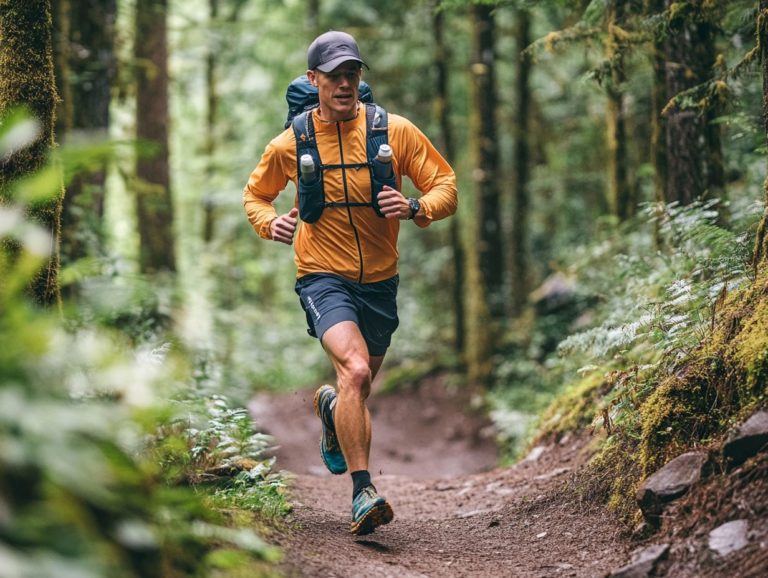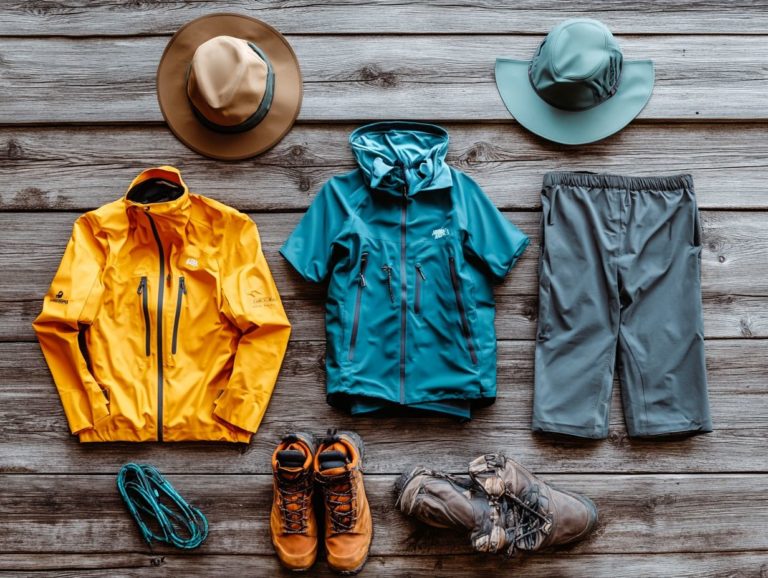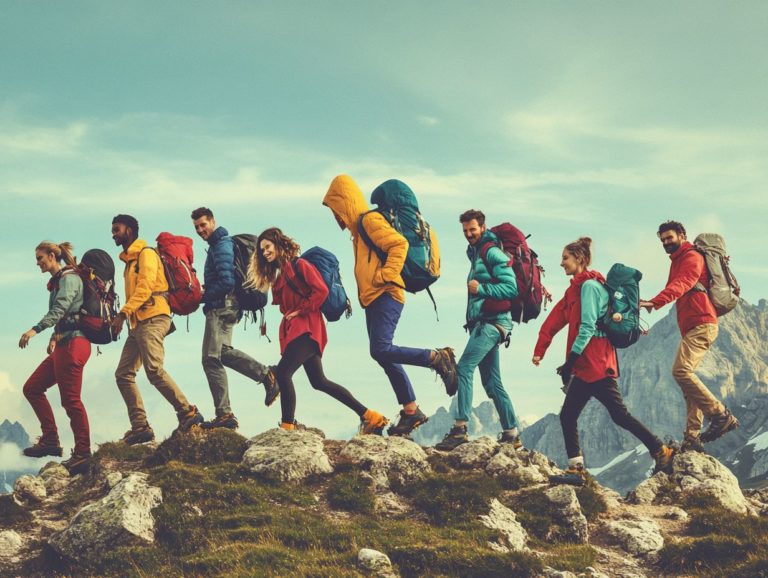How to Stay Comfortable While Hiking
Hiking offers a remarkable opportunity to connect with nature, but meticulous preparation is essential for a truly enjoyable experience.
From choosing the right gear to getting your body in shape, every detail matters especially when it comes to managing hydration, nutrition, and unexpected discomforts. Each of these steps plays a pivotal role in shaping your adventure.
This guide delves into everything you need to know, from anticipating the challenges of the trail to essential aftercare, ensuring you maximize your time in the great outdoors. Get ready to uncover the secrets for a fantastic hiking adventure!
Uncover the secrets to staying comfortable and safe while hiking.
Contents
- Key Takeaways:
- Preparing for a Hike
- Staying Comfortable on the Trail
- Dealing with Discomfort
- After the Hike
- Common Questions About Hiking Comfort
- What are some tips for staying comfortable while hiking?
- How can I prevent blisters while hiking?
- What should I pack to stay comfortable on a long hike?
- What can I do to stay comfortable while carrying a heavy backpack?
- Is it necessary to bring a change of clothes on a day hike?
- How should I prepare for a hike to stay comfortable?
Key Takeaways:

- Choose the right gear and physically prepare to ensure a comfortable hike.
- Maintain proper hydration and nutrition, manage temperature, and prevent injuries to stay comfortable on the trail.
- Manage muscle soreness and fatigue, cope with insect bites and sunburn, and properly recover and care for gear after the hike to deal with discomfort.
Preparing for a Hike
Preparing for a hike is a vital step in ensuring you have a safe and enjoyable outdoor adventure, especially if you re new to it and find the myriad of options overwhelming.
From choosing the right hiking gear and clothing to grasping the type of land of places like Mt. Baldy in Southern California, it s important to approach your preparations with a systematic mindset.
Familiarizing yourself with key tips such as understanding your map, timing it right, and knowing the local regulations regarding hiking permits will make your hike much more enjoyable.
Sharing your plans with someone adds safety, especially on challenging trails.
Choosing Your Gear
Choosing the right gear is fundamental to your hiking success. It ensures you enjoy comfort, safety, and efficiency on the trail.
Understanding the significance of each essential hiking item can truly elevate your experience. Quality hiking boots, for example, are crucial for providing the support you need on uneven terrain, reducing the risk of slips or falls. A reliable pack large enough to carry your necessary supplies but not so bulky that it becomes a burden is key to maintaining your energy during those long treks. Additionally, knowing how to stay cool while hiking in summer is essential, as hydration packs are designed for easy access to water, ensuring you stay hydrated, especially in warmer climates.
If you re just starting out, consider investing in versatile items that adapt to various conditions. Focus on fit and durability while resisting the urge to overpack. This will set you up for an enjoyable adventure ahead.
Physical Fitness
Physical preparation is key to ensuring you can fully enjoy your hike without unnecessary strain, especially when tackling challenges that demand stamina and endurance.
Being physically fit gives you the power to face steep inclines and uneven terrain with confidence and ease, significantly reducing the risk of injury. By engaging in workout routines that emphasize strength, flexibility, and stamina, you can dramatically enhance your performance on the trails.
Incorporating exercises like lunges, squats, and step-ups not only builds muscle strength but also improves your balance.
When hiking, pacing yourself is vital. Maintaining a steady rhythm helps you conserve energy while allowing you to soak in the breathtaking views. When you prepare physically, you create a more rewarding experience, whether you’re on a short jaunt or an extended adventure, fostering a deeper connection with the beauty of nature.
Staying Comfortable on the Trail
Staying comfortable on the trail transcends merely possessing the right gear; it demands a nuanced understanding of the common rules to follow while hiking to ensure everyone enjoys the experience and the ability to adapt to the unpredictable weather conditions that may unfold during your journey. Remember to follow leave no trace principles to protect the environment.
Don’t wait get out there and explore the beauty of nature!
Maintaining Proper Hydration and Nutrition
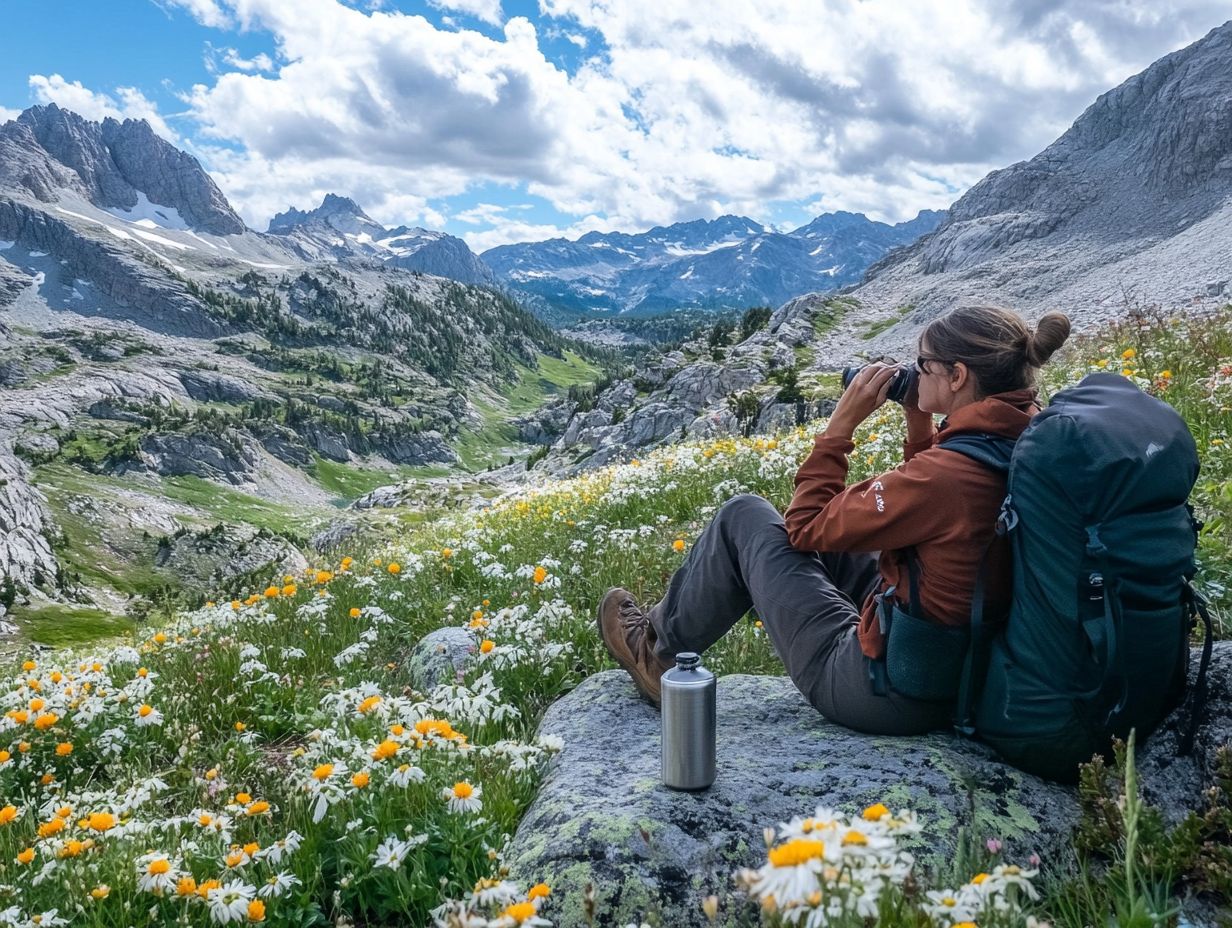
Proper hydration and nutrition are essential during hikes, directly influencing your energy levels and overall hiking experience. By prioritizing these factors, you boost not only your physical endurance but also your mood and focus amid nature s splendor.
Using hydration packs can streamline your water intake, providing hands-free access and ensuring you stay hydrated, especially on warmer days. Pair this strategy with energizing snacks like nuts, dried fruits, or energy bars to sustain your energy throughout the trek.
Mindfully adopting these nutrition strategies allows you to immerse yourself in breathtaking surroundings without succumbing to fatigue or depletion.
Managing Temperature and Weather
Stay comfortable and safe by managing temperature and weather conditions while hiking. Thoughtful clothing choices and awareness of your surroundings are key.
Dressing in layers helps you adjust your attire to fit fluctuating temperatures throughout the day. Wear moisture-wicking base layers to keep sweat away, insulating layers to trap warmth, and outer shells to guard against wind and rain.
Always check the weather forecast before heading out to avoid unpleasant surprises. Stay adaptable, as conditions can shift rapidly in the wilderness. Carry important safety gear like a map, GPS navigation, and a first aid kit to enhance your outdoor experience.
Being prepared allows you to relish nature s beauty safely, leading to a more rewarding exploration.
Preventing Blisters and Injuries
Preventing blisters and injuries is vital for a successful hiking experience, as these issues can turn an adventure into a painful ordeal, especially for beginners.
Selecting the right hiking boots for your foot shape and the terrain you ll encounter is crucial for comfort and support. Effective blister prevention tactics include wearing moisture-wicking socks and regularly adjusting your footwear.
For minor injuries, know basic first aid techniques, like applying antiseptic and having a clean bandage handy. Embracing hiking etiquette enhances your experience and promotes safety for fellow hikers, fostering a communal understanding of the trail. Additionally, make sure to learn how to stay hydrated while hiking to ensure a safe and enjoyable adventure.
Dealing with Discomfort
Navigating discomfort on the trail requires both preparation and keen awareness. Whether facing muscle soreness, fatigue, insect bites, or sunburn, managing these challenges can significantly improve your hiking experience.
Managing Muscle Soreness and Fatigue
Managing muscle soreness and fatigue is crucial for enjoying longer hikes and overcoming their challenges.
To tackle these issues, prepare for hikes with targeted workouts that enhance endurance. Incorporate strength training exercises like squats and lunges to build essential muscle groups. Staying hydrated and fueling your body with nutritious snacks will help maintain your activity levels.
Techniques like stretching and foam rolling before and after each hike can prevent muscle tightness and promote recovery, enriching your outdoor experience.
Coping with Insect Bites and Sunburn
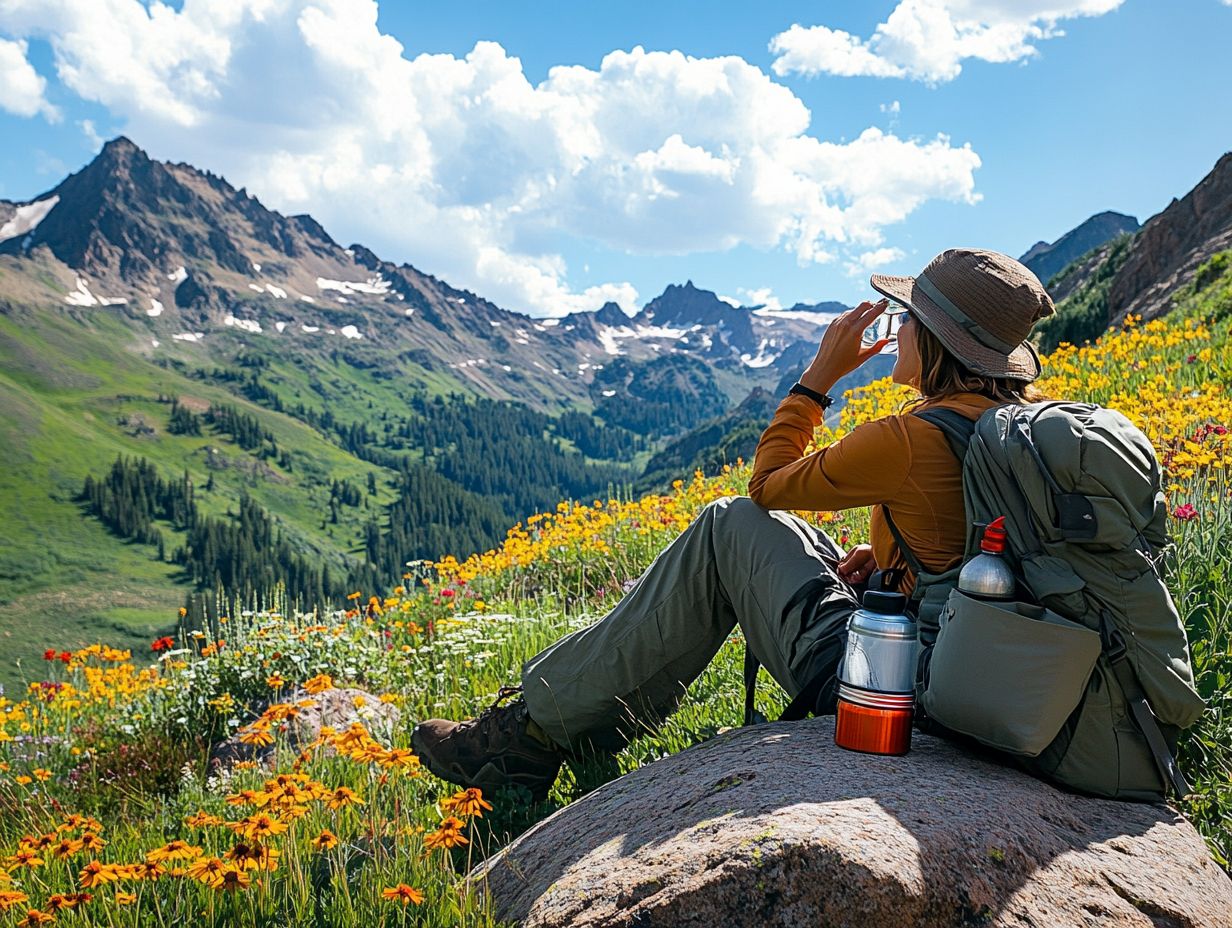
Coping with insect bites and sunburn is an essential part of outdoor safety. You should be well-prepared for it; using the right outdoor gear can significantly help.
To ensure your hiking experience is enjoyable and safe, taking proactive steps before you hit the trails is crucial. Wearing long sleeves and using insect repellent can help reduce your risk of those annoying bites from pesky critters. Additionally, it’s important to learn how to stay hydrated while hiking to keep your energy levels up. Protect your skin with sunscreen; it’s essential for enjoying your hike without worries, particularly in exposed areas.
Choosing trails with shaded routes helps prevent sunburn and makes your hike more enjoyable. And don’t forget to carry a basic first-aid kit; it’s your best friend when managing any bites or burns that may come your way, underscoring the importance of overall preparedness in the great outdoors. Additionally, learning how to stay warm while hiking is crucial, especially in the wilderness.
After the Hike
After completing a hike, prioritize recovery and rest as essential elements of the experience, especially if you’re part of a hiking group. This focus allows your body to recharge fully, preparing you for your next outdoor adventure.
Recovery and Rest
Rest and recovery are vital after a hike. By incorporating effective recovery techniques, you can enhance this process, allowing you to maintain your hiking regimen and embark on longer excursions.
- Stretching reduces muscle tension and boosts flexibility, helping to prevent injuries on future hikes.
- Stay hydrated by drinking plenty of water to replenish lost fluids, which aids muscle function and accelerates overall recovery.
- Focus on proper nutrition with a balanced intake of protein and carbohydrates to fuel your body while repairing tissue damage.
- Prioritize rest to give your muscles time to recover and rebuild, enhancing your stamina and performance for your next journey into nature.
Caring for Gear and Equipment
Caring for your hiking gear and equipment is essential for maintaining its functionality and longevity. This will directly influence your future hiking experiences. By dedicating just a bit of time and effort to regular cleaning, repairing, and proper storage, you can extend the life of your gear and elevate the quality of your outdoor adventures.
Incorporating simple practices like rinsing off dirt after each hike, inspecting for wear and tear, and storing your gear in a dry, cool place can make a remarkable difference.
Hiking groups are great places to learn tips and tricks for taking care of your gear. By tapping into these shared insights, you’ll discover methods that have proven successful for others.
Engaging in forums and attending local meet-ups can provide you with priceless information while strengthening your connections with others who share your passion for adventure.
Common Questions About Hiking Comfort
What are some tips for staying comfortable while hiking?

1. Wear appropriate clothing for the weather and activity level layers are key for adjusting to changing temperatures.
2. Make sure to wear comfortable, well-fitting shoes or hiking boots.
3. Take regular breaks and adjust your pace as needed.
4. Stay hydrated by bringing plenty of water with you and drinking regularly.
5. Protect yourself from the sun with sunscreen, a hat, and sunglasses.
6. Consider using hiking poles to help with balance and reduce strain on your joints.
Feel free to share your own tips or experiences to help our hiking community grow!
How can I prevent blisters while hiking?
Choose the right socks. Wear moisture-wicking socks designed for hiking.
Break in your shoes before the hike to avoid discomfort.
Use moleskin or blister pads. These can help prevent hot spots and blisters from forming.
Keep your feet dry. Change into dry socks if your feet get wet.
Apply foot powder or anti-chafing cream to areas prone to blisters.
Adjust your shoelaces for a comfy fit. This will reduce friction.
What should I pack to stay comfortable on a long hike?
- Bring enough water and snacks to maintain your energy levels.
- Pack a small first aid kit with blister pads, pain relievers, and necessary medications.
- Bring a lightweight, waterproof jacket for unexpected weather changes.
- Carry a lightweight, breathable hat to protect yourself from the sun.
- Include a small towel to wipe away sweat and cool down.
- Don’t forget bug spray and sunscreen, depending on your hiking destination.
What can I do to stay comfortable while carrying a heavy backpack?
Ensure your backpack is properly fitted to avoid strain and discomfort.
Pack heavy items close to your back and distribute weight evenly.
Take regular breaks to rest your shoulders and back.
Use a waist belt to transfer weight from your shoulders to your hips.
Maintain good posture by standing straight and using your core muscles for support.
Consider investing in a backpack with an internal frame for extra support.
Is it necessary to bring a change of clothes on a day hike?
Pack a spare set of clothes in case of unexpected weather or accidents.
If you sweat easily, bring a change of clothes to stay comfortable.
Include a warm, dry layer in case the temperature drops unexpectedly.
A fresh pair of socks can help prevent blisters and keep your feet comfortable.
It’s better to be over-prepared than under-prepared, so include a change of clothes.
If hiking with a group, carry a spare set in case someone else needs it.
How should I prepare for a hike to stay comfortable?
Research the trail and its difficulty to ensure it’s suitable for you.
Check the weather forecast and plan accordingly.
Gather all necessary gear, including a map or GPS and a fully charged phone.
Get a good night’s sleep before the hike to avoid fatigue.
Stretch and warm up before starting to prevent injuries.
Listen to your body and adjust your plans or take breaks as needed.



